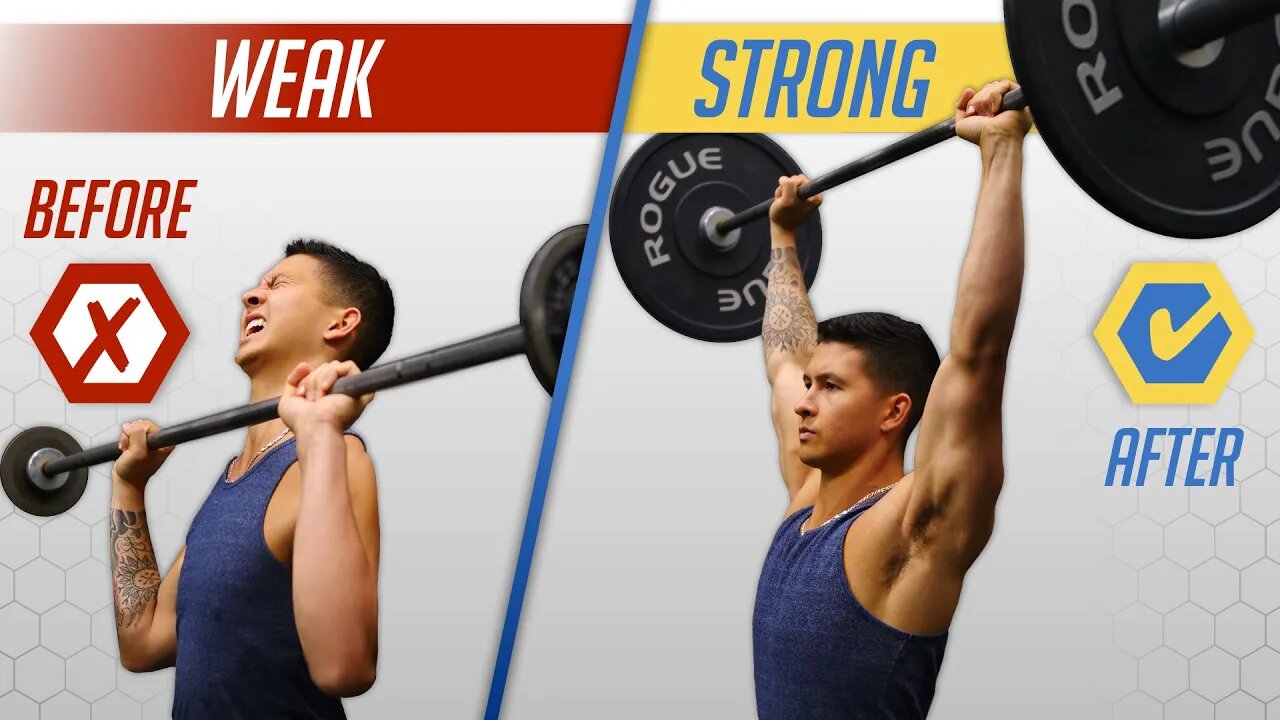Premium Only Content

How To Get A Stronger Overhead Press (FIX THIS!)
Want to learn how to overhead press more weight? Well, the harsh truth is that many individuals just aren’t ready to overhead press to begin with. More specifically, they lack the sufficient range of motion and mobility in key areas that then makes it considerably harder for them to press weight overhead. Which is why it may seem like you can’t achieve a stronger overhead press regardless of what you do. So, in this video I’ll cover 2 such restrictions that are the most common culprits (thoracic spine mobility and lat mobility), and how to test if you’re actually restricted in these areas. Fix these overhead mobility issues, and you’ll finally be able to increase your overhead press.
The first thing that’s limiting your strength with the overhead press is your thoracic spine mobility. An inability to extend at the mid-back has been shown to limit shoulder strength during overhead movements. Also, a tight mid-back often comes with tight lats. Which is why many of you watching will likely feel quite a bit of resistance even when you just press your arms overhead with no weight, and is again why many of you will tend to arch at the lower back whenever you attempt to press overhead. That said, there are two simple tests (occiput-to-Wall test and its progression) that’ll determine if there’s sufficient mobility in your mid-back and your lats for overhead pressing.
Lack mid-back mobility and/or lat mobility? It’s time to focus on these various restrictions. And you can do that with a simple 3 step routine. Step 1 of this routine involves mobilizing the problem areas, which are your mid-back and lats. So, all we’re going to do is take a foam roller or a sock stuffed with a couple tennis balls, and start foam rolling these areas. For your mid-back, place your hands behind your head to open up your shoulder blades, and just slowly roll out just that mid to upper back region for about 30 seconds or so. Then, move onto the lats by laying onto your side and rolling out your lats from your armpit all the way down to your lower back again for about 30 seconds per side.
Next, to continue building a stronger overhead press, it’s time to move onto active stretching. To do so, there’s 2 active stretches we’ll use. First, we’ll focus on the lats with an active lat stretch. Next, we’re going to seated wall slides, a move that’ll not only further actively stretch our lats but will also teach us how to use our increased thoracic mobility in an overhead pressing motion similar to the overhead press.
Next is the final piece of the puzzle. After improving your overhead mobility with the previous two steps, it’s important to now transfer and engrain that into your overhead pressing so that your brain understands how to use that increased range of motion under load, which will help achieve our goal of actually boosting your performance in that movement. What I’d suggest though is at first, lighten the weight and take time off barbell overhead pressing altogether as this requires the greatest mobility demands. Instead, you’ll want to overtime progress through the following exercises: the kneeling single arm kettlebell/dumbbell overhead press, the standing single arm dumbbell press, the standing two arm dumbbell press, then the standing barbell overhead press.
So, here’s the action plan that’ll help you increase your overhead press:
Step 1: Mobilize
Foam roll mid-back: 30-60 seconds
Foam roll lats: 30-60 seconds each side
Step 2: Active Stretching
Active lat stretch: 5-10 reaches per side with 1s holds at end position
Seated wall slides: 10-15 reps
Step 3: Skill
Progression 1: Kneeling Single Arm Kettlebell or Dumbbell Press
Progression 2: Standing Single Arm Kettle Bell or Dumbbell Press
Progression 3: Standing 2-Arm Dumbbell Press
Progression 4 (goal): Standing Barbell Press
*For each progression, perform ~3 sets of 8-12 reps and increase load as appropriate overtime
Trust me, I know that corrective exercises aren’t fun. But if you want to stop spinning your wheels in the gym and actually break through the plateau you’re stuck in, then you need to address these things as it’ll pay off with more gains and less injury in the long run. And for a step by step program that shows you exactly how to incorporate important corrective exercises like these into a weekly training routine so that you can build lean muscle and break through plateaus in the most effective way possible, then take the analysis quiz below to discover which approach is best for your body:
https://builtwithscience.com/bws-free...
Filmed by: Bruno Martin Del Campo
MUSIC:
https://soundcloud.com/iamryanlittle
Subscribe to my channel here:
https://www.youtube.com/jeremyethier/...
-
 LIVE
LIVE
TimcastIRL
2 hours agoDemocrats COLLUDED With Epstein To HURT Trump, Emails BACKFIRE
7,182 watching -
 LIVE
LIVE
Dr Disrespect
11 hours ago🔴LIVE - DR DISRESPECT - ARC RAIDERS - STELLA MONTIS QUESTS
617 watching -

SpartakusLIVE
5 hours agoSolos on WZ to Start then ARC?! || Friends: UNBANNED
9.95K -
 12:58
12:58
Cash Jordan
5 hours agoMexican MOB OVERTHROWS Capital... as "Socialist President" FLOODS AMERICA with CARTELS
1801 -
 23:13
23:13
Jasmin Laine
7 hours agoPBO Breaks His Silence—“This Is Soviet Stuff”… and the Panel EXPLODES
7929 -
 LIVE
LIVE
Jamie Kennedy
19 hours agoCatching Up With Deep Roy: JKX Stories, Star Wars Secrets, and Total Chaos | Ep 231 HTBITY
96 watching -
 LIVE
LIVE
ThisIsDeLaCruz
1 hour agoThe Secrets Behind Madonna’s Legendary Live Sound
77 watching -
 1:22:15
1:22:15
Glenn Greenwald
5 hours agoTrump and JD Vance Weigh in on the MAGA Civil War Over Tucker; Zelensky's Top Associates Embroiled in $100 Million Corruption Scandal; FBI's Ongoing Concealment About Trump Shooter | SYSTEM UPDATE #548
94.3K89 -
 LIVE
LIVE
megimu32
2 hours agoON THE SUBJECT: 2000s Pop Punk & Emo Nostalgia — Why It Still Hits
139 watching -
 LIVE
LIVE
VapinGamers
2 hours ago $0.20 earnedBattlefield RedSec - Getting Carried Maybe? I Need the Wins! - !rumbot !music
103 watching